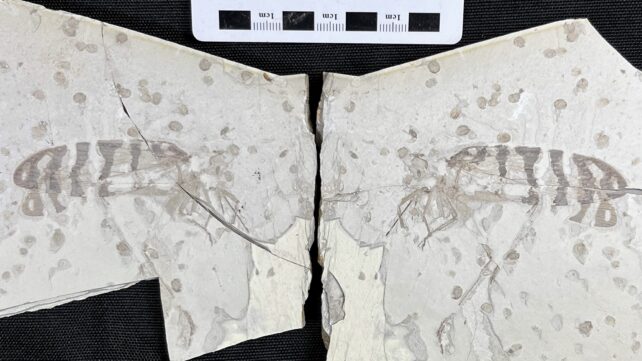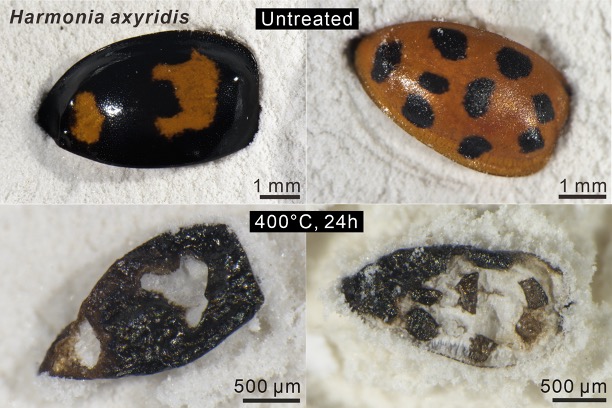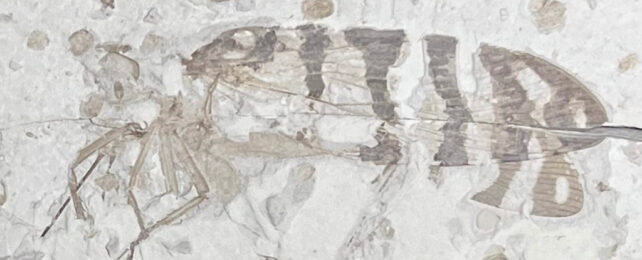Magnificent as they are, most fossils are rather monochromatic, prompting paleontologists to go to great lengths to infer what color those ancient organisms might have been.
Some exceptional fossils have preserved the pigment molecules in dinosaur feathers and scaly skin. But given the millions of years that separate us from the lives of those ancient animals, scientists aren't entirely sure how the process of fossilization might have meddled with those chemical imprints.
To take some of the guesswork out of imagining the colors of fossilized creatures, a team of researchers from China and Ireland has run a series of lab experiments to join the dots between the tonal patterns often seen on fossilized insects and the properties of the original tissue, to confirm the true nature of their coloration.
"Many fossil insects show monochromatic color patterns that may provide valuable insights into ancient insect behavior and ecology," Nanjing University paleontologist Shengyu Wang and colleagues write in their published paper.
"Whether these patterns reflect original pigmentary coloration is, however, unknown, and their formation mechanism has not been investigated."
Fossilized insects often display blackish-brown spots, stripes, or blotches – patterns which could, the researchers hypothesized, reflect the thickness and hardening of insect exoskeletons or the pigment content of those tissues.

While such tonal patterns may not rival the dazzling colors of iridescent insects preserved in amber, the patterns could still represent important clues on insect appearances.
Using light and scanning electron microscopy, the researchers imaged a fossilized orthopteran known for having striking monochromatic patterns on its wings, akin to the modern-day banded-wing grasshopper. Only in the dark bands did they find traces of the insect's exoskeleton.
Next, Wang and colleagues selected three present-day beetle species with simple patterning, wrapped their exoskeletons in aluminum foil, and baked them at temperatures between 200 °C and 500 °C to simulate fossilization.
Examining the specimens using scanning electron microscopy, the researchers found the dark patches that remained were indeed from the pigmented parts of the exoskeleton, rich in melanin. Those spots resisted heat degradation while melanin-poor areas were lost, as you can see in the image below.

Somewhat strangely, the heated specimens went through an intermediary phase of degradation where they turned black all over before revealing their patterns once more.
The results suggest that if a specimen's dark hues are uniform, it might just be an artifact of fossilization. Striped or blotchy patterns, however, could be considered representative of the fossilized insects' original color palette, the researchers conclude.
Chemical evidence of melanin has been found before, in the dark-colored exoskeleton remains of other fossil insects, including a beetle, wasp, and damselfly.
But despite insects' great abundance, and a fossil record that stretches back to the Early Devonian period, some 400 million years ago – when the first vascular plants were just getting a foothold – the coloration of fossilized insects has been largely overlooked compared to vertebrates.
Wang and colleagues say their experimental study "opens new avenues" for interpreting insect fossils, now that we have a better idea of how insects are preserved.
"Our data represent the first empirical evidence that the monochromatic patterns in compression fossils of insects are biological in origin and represent melanin-based color patterns," Wang and colleagues write.
Given what we've come to understand about how evolution favors certain colors, they hope future studies comparing their tonal patterns through deep time could "yield valuable insights into the functional evolution of insect coloration, behavior and physiology in ancient ecosystems."
The study has been published in Proceedings of the Royal Society B: Biological Sciences.
